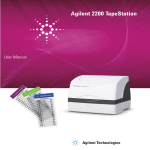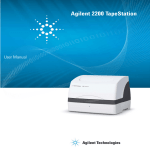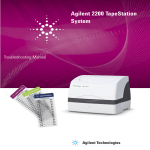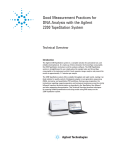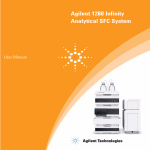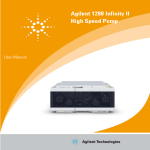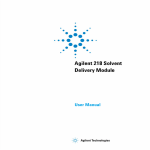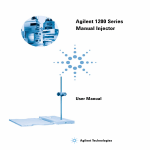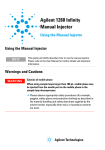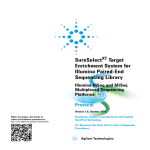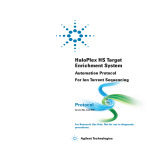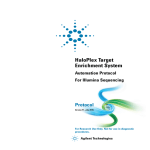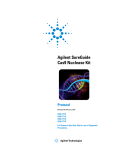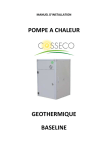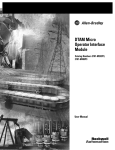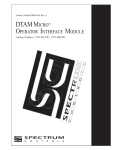Download Agilent 2200 TapeStation - User Manual
Transcript
Agilent 2200 TapeStation User Manual Agilent Technologies Notices © Agilent Technologies, Inc. 2011-2012, 2013 No part of this manual may be reproduced in any form or by any means (including electronic storage and retrieval or translation into a foreign language) without prior agreement and written consent from Agilent Technologies, Inc. as governed by United States and international copyright laws. Manual Part Number G2964-90002 Rev. B Edition 10/2013 Printed in Germany Agilent Technologies Hewlett-Packard-Strasse 8 76337 Waldbronn This product may be used as a component of an in vitro diagnostic system if the system is registered with the appropriate authorities and complies with the relevant regulations. Otherwise, it is intended only for general laboratory use. Warranty The material contained in this document is provided “as is,” and is subject to being changed, without notice, in future editions. Further, to the maximum extent permitted by applicable law, Agilent disclaims all warranties, either express or implied, with regard to this manual and any information contained herein, including but not limited to the implied warranties of merchantability and fitness for a particular purpose. Agilent shall not be liable for errors or for incidental or consequential damages in connection with the furnishing, use, or performance of this document or of any information contained herein. Should Agilent and the user have a separate written agreement with warranty terms covering the material in this document that conflict with these terms, the warranty terms in the separate agreement shall control. receive no greater than Restricted Rights as defined in FAR 52.227-19(c)(1-2) (June 1987). U.S. Government users will receive no greater than Limited Rights as defined in FAR 52.227-14 (June 1987) or DFAR 252.227-7015 (b)(2) (November 1995), as applicable in any technical data. Safety Notices CAUTION A CAUTION notice denotes a hazard. It calls attention to an operating procedure, practice, or the like that, if not correctly performed or adhered to, could result in damage to the product or loss of important data. Do not proceed beyond a CAUTION notice until the indicated conditions are fully understood and met. Technology Licenses The hardware and/or software described in this document are furnished under a license and may be used or copied only in accordance with the terms of such license. Restricted Rights Legend If software is for use in the performance of a U.S. Government prime contract or subcontract, Software is delivered and licensed as “Commercial computer software” as defined in DFAR 252.227-7014 (June 1995), or as a “commercial item” as defined in FAR 2.101(a) or as “Restricted computer software” as defined in FAR 52.227-19 (June 1987) or any equivalent agency regulation or contract clause. Use, duplication or disclosure of Software is subject to Agilent Technologies’ standard commercial license terms, and non-DOD Departments and Agencies of the U.S. Government will WA R N I N G A WARNING notice denotes a hazard. It calls attention to an operating procedure, practice, or the like that, if not correctly performed or adhered to, could result in personal injury or death. Do not proceed beyond a WARNING notice until the indicated conditions are fully understood and met. Agilent 2200 TapeStation - User Manual Contents Contents 1 Introduction to the 2200 TapeStation System Overview of the System 2 Specifications 5 6 11 Technical Specifications 12 ScreenTape Specifications 14 3 Installing the System 21 Unpacking the System 22 Contents of the ScreenTape System Installing the System 27 24 4 Using the 2200 TapeStation System 31 Intended Use of the 2200 TapeStation System 33 Performance Limitations of Use 34 Additional Components Required by the User 35 Operating Procedure 36 How to prepare your samples 48 Good Measurement Practices for Analysing DNA on the Agilent 2200 TapeStation 50 DNA Sample Preparation 57 RNA Sample Preparation 63 Protein Sample Preparation 69 5 Maintenance 73 General Information 74 Changing the Needle 75 Agilent 2200 TapeStation - User Manual 3 Contents 6 Appendix 79 Limited Use Label License 80 Sound Emission 81 The Waste Electrical and Electronic Equipment Directive Technical Service 83 4 82 Agilent 2200 TapeStation - User Manual Agilent 2200 TapeStation - User Manual 1 Introduction to the 2200 TapeStation System Overview of the System 6 ScreenTape Architecture 7 Agilent 2200 TapeStation Components 8 This chapter gives an introduction to the system Agilent Technologies 5 1 Introduction to the 2200 TapeStation System Overview of the System Overview of the System The Agilent 2200 TapeStation system is a revolutionary tape- based platform for simpler, faster and more reliable electrophoresis. It is made up of three elements: a consumable tape (ScreenTape), an instrument (the 2200 TapeStation) and an analysis software. The system is very straightforward to use, simply place the sample tubes and ScreenTape in to the 2200 TapeStation and let it load, separate, image, analyse and present the results. Place ScreenTape and some tips in the 2200 TapeStation. Place your samples in the 2200 TapeStation and click Start on the controller software. View your analysed results in around 1 min per sample. This User Manual guides the operation of ScreenTape, the 2200 TapeStation and software for the analysis of DNA, RNA and protein samples. The contents of the ScreenTape System are detailed below. Information pertaining to the 2200 TapeStation can be found in: • 2200 TapeStation Technical Specification • 2200 TapeStation Components • Installing the 2200 TapeStation 6 Agilent 2200 TapeStation - User Manual Introduction to the 2200 TapeStation System Overview of the System 1 Information pertaining to sample and ScreenTape requirements can be found in: • ScreenTape Architecture • Operating Procedure ScreenTape Architecture Barcode: The unique barcode tracks lane usage within individual ScreenTape and allows traceability of results. Buffer chamber: The buffer chamber is located at the top of the channel and contains optimised buffers for the effective separation of nucleic acid fragments or proteins. Electrodes: The integrated electrodes apply a current across the ScreenTape and eliminate the need for any additional electrophoresis equipment. Gel: The gel contained within ScreenTape has been developed specifically to resolve nucleic acids or proteins. ScreenTape product details: The information is unique to each consumable item. This includes: ScreenTape type, product expiry date and a unique serial number. Figure 1 Example: P200 ScreenTape Agilent 2200 TapeStation - User Manual 7 1 Introduction to the 2200 TapeStation System Overview of the System Agilent 2200 TapeStation Components 8 Lid: The 2200 TapeStation lid must be closed each time the instrument controller software is initialized, and whilst the instrument is in operation. LED: The LED will illuminate once the instrument is on. When the LED is flashing slowly, the instrument is in use and the lid should not be opened, rapid flashing indicates that the TapeStation requires some attention. Sample Block: There are 2 sample blocks provided that can either hold 0.2 mL sample tube strips or a 96 well plate. Tip Holder: The tip holder can accommodate up to 16 TapeStation loading tips at any one time. ScreenTape: The tape must be placed into the holder with the barcode towards the front of the instrument, facing towards the right. USB Socket: The USB connector is inserted into the USB socket to link the laptop to the 2200 TapeStation. Power-cable socket: The power cable must be connected to the 2200 TapeStation and the relevant mains electricity outlet. Agilent 2200 TapeStation - User Manual Introduction to the 2200 TapeStation System Overview of the System 1 Lid ScreenTape Tip holder Sample block LED Figure 2 2200 TapeStation (front view) Figure 3 2200 TapeStation (back view) On/off switch Power-cable socket USB socket Agilent 2200 TapeStation - User Manual 9 1 10 Introduction to the 2200 TapeStation System Overview of the System Agilent 2200 TapeStation - User Manual Agilent 2200 TapeStation - User Manual 2 Specifications Technical Specifications ScreenTape Specifications 12 14 This chapter provides information on specifications. Agilent Technologies 11 2 Specifications Technical Specifications Technical Specifications 2200 TapeStation Input voltage: 12 V DC Power consumption: 40 W (VA) Current: 3A Interface: USB cable (PC comms.) Instrument Housing: UL94/VO rated flame retardant cast polyurethane Dimensions: 400 x 310 x 310 mm Weight: 12.5 kg Power Supply Input voltage: 100 – 240 V AC Input frequency: 50 – 60 Hz Phase: 1 Current: 0.45 – 1.1 A Environmental condition Optimal operating temperature 23 °C (73.4 °F). Instrument operating temperature1 12 – 37 °C (53.6 – 98.6 °F) for D1000 ScreenTape 17 – 37 °C (62.6 – 98.6 °F) for High Sensitivity D1000 ScreenTape 15 – 30 °C (59.0 – 86.0 °F) for Genomic DNA ScreenTape 14 – 30 °C (57.2 – 86.0 °F) for RNA and High Sensitivity RNA ScreenTape 10 – 33 °C (50.0 – 91.4 °F) for P200 ScreenTape 1 12 Instrument operating temperature may be higher than ambient lab temperature, especially after prolonged use. Agilent 2200 TapeStation - User Manual Specifications Technical Specifications NOTE 2 If the instrument is out of the recommended temperature range for the ScreenTape inserted the following error message will appear in the controller software: • If the quoted current temperature is above the specified range, please move the system out of direct sunlight and away from any windows. Check that any air conditioning is functioning. • If the quoted current temperature is below the specified range please allow the instrument to equilibrate to the ambient temperature, and avoid using in a cooled area. Agilent 2200 TapeStation - User Manual 13 2 Specifications ScreenTape Specifications ScreenTape Specifications Specification (D1000 ScreenTape Assay) Analytical Specifications D1000 ScreenTape and Reagents Sizing Range 35 – 1000 bp Typical Resolution 35 – 300 bp: 15 % 300 – 1000 bp: 10 % Sensitivity1 0.1 ng/µL Sizing Precision 5 % CV Sizing Accuracy2 ±10 % Quantitative Precision 0.1 – 1 ng/µL: 15 % CV 1 – 50 ng/µL: 10 % CV Quantitative Accuracy3 ±20 % Quantitative Range 0.1 – 50 ng/µL Physical Specifications 14 Analysis Time 16 samples: <20 min 96 samples: ≈100 min Samples per consumable 16 Sample volume required 1 µL Kit stability 4 months Kit size 112 samples 1 signal-to-noise >3 (single peak) 2 Sizing Accuracy for software ladder: ±20% 3 Measured against 2100 Bioanalyzer Agilent 2200 TapeStation - User Manual Specifications ScreenTape Specifications 2 Specification (High Sensitivity D1000 ScreenTape Assay) Analytical Specifications High Sensitivity D1000 ScreenTape and Reagents Sizing Range 35 – 1000 bp Typical Resolution 35 – 300 bp: 15 % 300 – 1000 bp: 10 % Sensitivity1 5 pg/µL Sizing Precision 5 % CV Sizing Accuracy2 ±10 % Quantitative Precision 15 % CV Quantitative Accuracy3 ±20 % Quantitative Range 10 – 1000 pg/µL Physical Specifications Analysis Time 16 samples: <20 min 96 samples: ≈100 min Samples per consumable 16 Sample volume required 2 µL Kit stability 4 months Kit size 112 samples 1 signal-to-noise >3 (single peak) 2 Sizing Accuracy for software ladder: ±20% 3 Measured against 2100 Bioanalyzer Agilent 2200 TapeStation - User Manual 15 2 Specifications ScreenTape Specifications Specification (Genomic DNA ScreenTape Assay) Analytical Specification Genomic DNA ScreenTape and Reagents Sizing Range 200 bp to > 60000 bp Sensitivity 0.5 ng/µL Sizing Precision1 200 – 15000 bp: 15 % CV Sizing Accuracy1 200 – 15000 bp: ±10 % Quantitative Precision2 15 % CV Quantitative Accuracy3 ±20 % Linear Concentration Range 10 – 100 ng/µL Carry Over N/A Physical Specification 16 Analysis Time 16 samples: < 25 min 96 samples: < 150 min Samples per consumable 16 Sample Volume Required 1 µL Shelf Life 4 months Box/Kit size 112 samples/box 1 Determined using the Genomic DNA Ladder as sample 2 Average result from various genomic DNA sample types Agilent 2200 TapeStation - User Manual Specifications ScreenTape Specifications 2 Specification (RNA ScreenTape Assay) Analytical Specification RNA ScreenTape and Reagents Quality Score RINe Quantitative Range 25 – 500 ng/µL Quantitative Precision (%CV)1 5% Quantitative Accuracy 20 % Sizing Range 100 – 6000 nt Sensitivity2 5 ng/µL Analysis Type Eukaryotic or Prokaryotic Total RNA QC Maximum sample buffer strength 200 mM Tris 20 mM EDTA or 50 mM NaCl Physical Specifications Analysis Time 16 samples < 16 min 96 samples < 100 min Samples per consumable 16 Sample volume required (µL) 1 Kit Stability 4 months Kit Size 112 samples For total RNA samples 1 Within a ScreenTape Agilent 2200 TapeStation - User Manual 2 Signal/noise >3 in water and TE 17 2 Specifications ScreenTape Specifications Specification (High Sensitivity RNA ScreenTape Assay) Analytical Specification RNA ScreenTape and Reagents Quality Score RINe Quantitative Range 500 – 10000 pg/µL Quantitative Precision (%CV)1 10 % Quantitative Accuracy 30 % Sizing Range 100 – 6000 nt Sensitivity2 100 pg/µL Analysis Type Eukaryotic or Prokaryotic Total RNA QC Maximum sample buffer strength 10 mM Tris 1 mM EDTA Physical Specifications Analysis Time 16 samples < 30 min 96 samples < 180 min Samples per consumable 16 Sample volume required (µL) 2 Kit Stability 4 months Kit Size 112 samples For total RNA samples 1 Within a ScreenTape 18 2 Signal/noise >3 in water and TE Agilent 2200 TapeStation - User Manual Specifications ScreenTape Specifications 2 Specification (P200 ScreenTape Assay) Analytical Specification P200 ScreenTape and Reagents Sizing range 10 – 200 kDa Resolution1 15 % Typical Sizing Accuracy ±10 % (CAII, Lysozyme, beta lactoglobulin) Sizing Precision 3 % CV Quantitative Range/precision 100 – 1000 ng/µL for IgG; 15 % CV Qualitative Range 5 – 5000 ng/µL BSA, Lysozyme; 12.5 – 5000 ng/µL IgG Sensitivity2 5 ng/µL Lysozyme; 12.5 ng/µL IgG Physical Specification Sample volume needed 2 µL Analysis Time 16 samples: <15 min Samples/consumable 16 Kit Size 112 Samples Kit Stability 4 months 1 determined using P200 Lader as sample 2 signal :noise ratio > 3 Agilent 2200 TapeStation - User Manual 19 2 20 Specifications ScreenTape Specifications Agilent 2200 TapeStation - User Manual Agilent 2200 TapeStation - User Manual 3 Installing the System Unpacking the System 22 Contents of the ScreenTape System 24 Installing the System 27 Software Installation 27 Agilent 2200 TapeStation Set Up 28 This chapter gives information about how to install the system. Agilent Technologies 21 3 Installing the System Unpacking the System Unpacking the System Unpacking the Agilent 2200 TapeStation Prerequisites CAUTION Do not attempt to unpack the 2200 TapeStation instrument until you have read the accompanying Site and Safety Manual. Condensation within the instrument Condensation will damage the system electronics. ➔ If your instrument was shipped in cold weather, leave it in its box and allow it to warm slowly to room temperature to avoid condensation. CAUTION "Defective on arrival" problems If there are signs of damage, please do not attempt to install the instrument. Inspection by Agilent is required to evaluate if the instrument is in good working condition. ➔ Notify your local Agilent Representative and the Technical support channel. ➔ An Agilent service representative will inspect the instrument at your site and initiate appropriate actions. WA R N I N G Personal injury The TapeStation is heavy. ➔ Enlist the aid of a co-worker to share the lifting load to avoid personal injury. 1 Remove the TapeStation from the packaging and place on a clean, dry, flat surface. 2 Allow the TapeStation to acclimatise to the ambient temperature of the operating environment. 22 Agilent 2200 TapeStation - User Manual Installing the System Unpacking the System 3 3 Remove the label covering the tape holder, as shown in the image below. Figure 4 Remove before use Delivery Checklist Ensure all parts and materials have been delivered with your system. The delivery checklist is shown below. Please report any missing or damaged parts to your local Agilent Technologies sales and service office. Agilent 2200 TapeStation - User Manual 23 3 Installing the System Contents of the ScreenTape System Contents of the ScreenTape System The Agilent 2200 TapeStation Table 1 The Agilent 2200 TapeStation System (G2964AA, G2965AA) Product Volume Properties Agilent 2200 TapeStation 1x Instrument for loading, electrophoresing, imaging and analysing: • 2200 TapeStation System (G2964AA) or • 2200 TapeStation Nucleic Acid System (G2965AA) TapeStation Software Setup Disc 1 x CD The software is required to drive the 2200 TapeStation and visualise the ScreenTape analysis Laptop 1 x Laptop Instrument Control Laptop USB Cables/Power supply units 1 x USB cable 2 x power cords 1 x USB cable to connect the laptop to the TapeStation 1 x Power supply unit for the laptop 1 x Power supply unit for the TapeStation Sample Block 1 x 0.2 mL strip and 1 x 96 well plate A removable sample block for the correct loading of samples within the TapeStation Tip Holder 2x A removable cartridge for pipette tips placed in the TapeStation TapeStation loading tips 1 x 384 tips Pipette tips to use in the 2200 TapeStation TapeStation compatible 0.2 mL tube strips and lids 1x box of 120 tubes and caps Tube strips for placing samples mixed with loading buffer into the 2200 TapeStation 96 well plates pack of 10 96 well plate foil seal pack of 100 Loading tip transfer tool (optional) 1x IKA Vortexer and associated PCR plate (optional) 1x Guides 24 Vortexer for mixing samples and reagents Site Safety guide and Quick Guides (G2964AA - Protein, DNA and RNA; G2965AA - DNA and RNA) Agilent 2200 TapeStation - User Manual Installing the System Contents of the ScreenTape System 3 ScreenTape Products Kit Components (High Sensitivity D1000 ScreenTape Assay) Part Number Name Color Amount 5067-5584 High Sensitivity D1000 ScreenTape 7 ScreenTape 5067-5585 High Sensitivity D1000 Regents • High Sensitivity D1000 Ladder • High Sensitivity D1000 Sample Buffer 2 vials 20 µL 300 µL 5067-5587 High Sensitivity D1000 Ladder 1 vial 20 µL Kit Components (D1000 ScreenTape Assay) Part Number Name Color Amount 5067-5582 D1000 ScreenTape 7 ScreenTape 5067-5583 D1000 Reagents • D1000 Ladder • D1000 Sample Buffer 2 vials 10 µL 400 µL 5067-5586 D1000 Ladder 1 vial 10 µL Kit Components (Genomic DNA ScreenTape Assay) Part Number Name 5067-5365 Genomic DNA ScreenTape 7 ScreenTape 5067-5366 Genomic DNA Reagents • Genomic DNA Ladder • Genomic DNA Sample Buffer 2 vials 75 µL 1350 µL Agilent 2200 TapeStation - User Manual Color Amount 25 3 Installing the System Contents of the ScreenTape System Kit Components (High Sensitivity RNA ScreenTape Assay) Part Number Name Color Amount 5067-5579 High Sensitivity RNA ScreenTape 7 ScreenTape 5067-5580 High Sensitivity RNA ScreenTape Sample Buffer 1 vial 250 µL 5067-5581 High Sensitivity RNA ScreenTape Ladder 1 vial 10 µL Kit Components (RNA ScreenTape Assay) Part Number Name Color Amount 5067-5576 RNA ScreenTape 7 ScreenTape 5067-5577 RNA ScreenTape Sample Buffer 1 vial 600 µL 5067-5578 RNA ScreenTape Ladder 1 vial 10 µL Kit Components (P200 ScreenTape Assay) Part Number Name 5067-5371 P200 ScreenTape 7 ScreenTape 5067-5372 P200 Reagents • P200 5X Labeling Dye • P200 Labeling Buffer • P200 Reducing Sample Buffer • P200 pH Buffer • P200 Non-Reducing Sample Buffer • P200 Markers (pre-stained) • P200 Ladder 70 µL 350 µL 550 µL 1000 µL 550 µL 270 µL 40 µL 26 Color clear Amount Agilent 2200 TapeStation - User Manual Installing the System Installing the System 3 Installing the System Software Installation The software for your Agilent 2200 TapeStation system is preinstalled on the system laptop. NOTE For updates, or if you have to change the laptop, you may download the latest version of the software from the update server http://www.agilent.com/genomics/tapestation. For details on installation of the software refer to the readme.txt file on the installation CD Agilent 2200 TapeStation Software TAPESTATION INSTRUMENT CONTROL AND DATA ANALYSIS. Agilent 2200 TapeStation - User Manual 27 3 Installing the System Installing the System Agilent 2200 TapeStation Set Up Hardware required Laptop Software required Agilent 2200 TapeStation Software (already installed) WA R N I N G Personal injury, explosion or fire ➔ Do not operate the instrument in an atmosphere containing explosive gases or near flammable volatile liquids. ➔ Only approved mains cord set supplied with the instrument must be used with this instrument and if an extension lead is required, the lead must be earthed. ➔ If the equipment is used in a manner not specified by the manufacturer, the protection provided by the equipment may be impaired. NOTE WA R N I N G For general safety information, please refer to the 2200 TapeStation System - Site and Safety Manual. Use of unsupplied cables or power adaptors Using cables or power adaptors not supplied by Agilent Technologies can lead to damage of the electronic components or personal injury. ➔ Never use cables or power adaptors other than the ones supplied by Agilent Technologies to ensure proper functionality and compliance with safety or EMC regulations. 1 Connect the supplied USB cable between the port on the back of the instrument and your laptop. 2 Power the instrument with the supplied power lead and adaptor. 3 Turn the instrument on using the power switch located at the back of the TapeStation. When powered and idle, the instrument will have a blue LED visible on the front of the case. 28 Agilent 2200 TapeStation - User Manual 3 Installing the System Installing the System 4 Windows may display a Found New Hardware wizard once the software has loaded. In this instance, always perform the following steps: a Select No, not this time to prevent connecting to Windows Update and searching for software. b In the next window select Install the Software automatically. c If a window appears, indicating the software did not pass the windows logo testing, click Continue Anyway. A window appears, indicating that the hardware has been successfully installed. The TapeStation system will function. NOTE As there is more than one driver that can be detected and installed, you may need to follow these steps more than once. You may need to follow these steps if you change the USB port on the laptop for the TapeStation connector cable. Agilent 2200 TapeStation - User Manual 29 3 30 Installing the System Installing the System Agilent 2200 TapeStation - User Manual Agilent 2200 TapeStation - User Manual 4 Using the 2200 TapeStation System Intended Use of the 2200 TapeStation System Performance Limitations of Use 33 34 Additional Components Required by the User 35 Operating Procedure 36 Add Experiment Notes 41 Describe Samples 42 Start the TapeStation Run 44 Final Check 44 Running System 45 Abort the TapeStation Run 45 Complete TapeStation Run 45 Empty Tip Buckets 46 How to Use the Agilent TapeStation Software Shutdown and Restarting Procedure 47 How to prepare your samples 46 48 Good Measurement Practices for Analysing DNA on the Agilent 2200 TapeStation 50 Quantification 50 Sizing 53 Genomic DNA 54 Molarity 56 DNA Sample Preparation 57 Sample Preparation D1000 ScreenTape Assay 59 Sample Preparation High Sensitivity D1000 ScreenTape Assay Sample Preparation Genomic DNA ScreenTape Assay 61 RNA Sample Preparation 63 Sample Preparation RNA ScreenTape Assay 65 Sample Preparation High Sensitivity RNA ScreenTape Assay Agilent Technologies 60 67 31 4 Using the 2200 TapeStation System Installing the System Protein Sample Preparation 69 Sample Preparation P200 ScreenTape Assay 70 This chapter explains the intended use of the 2200 TapeStation System. 32 Agilent 2200 TapeStation - User Manual Using the 2200 TapeStation System Intended Use of the 2200 TapeStation System 4 Intended Use of the 2200 TapeStation System The 2200 TapeStation system (Agilent 2200 TapeStation Software) carries out electrophoretic separation of Nucleic Acids and proteins. The system detects: • Fluorescently stained double stranded DNA including genomic DNA • Fluorescently stained total RNA (Eukaryotic and Prokaryotic) • Fluorescently labelled proteins Agilent 2200 TapeStation - User Manual 33 4 Using the 2200 TapeStation System Performance Limitations of Use Performance Limitations of Use The 2200 TapeStation System (Agilent 2200 TapeStation Software) can analyse a maximum of 16 samples at any one time, more samples can be run using a 96 well plate and multiple ScreenTape. The user is responsible for establishing performance characteristics necessary for upstream and downstream applications. Appropriate controls must be included in any upstream application requiring analysis on the 2200 TapeStation System (Agilent 2200 TapeStation Software). 34 Agilent 2200 TapeStation - User Manual 4 Using the 2200 TapeStation System Additional Components Required by the User Additional Components Required by the User Additional Consumables required for the 2200 TapeStation instrument • Loading tips, (5067- 5152) / Loading tips, (5067- 5153) • Optical Tube 8x Strip, Box of 120, (401428) and Optical Cap 8x Strip, Box of 120, (401425) or - well Sample Plates, Pack of 10 plates (5067- 5150) and - well Plate Foil Seal, Pack of 100 foils (5067- 5154) • Vortex mixer (See note below) Additional Material Required (Not Supplied) • Volumetric pipette • Centrifuge • Heating block or PCR machine NOTE Mixing recommendations • TapeStation instruments are supplied with an optional IKA MS3 vortexer which includes a 96 well plate adaptor suitable for both 96 well PCR plates and 8 way strips. • This vortexer is recommended for use with the following applications: • D1000 ScreenTape Assay • High Sensitivity D1000 ScreenTape Assay • RNA ScreenTape Assay • High Sensitivity RNA ScreenTape Assay • It is recommended that all current TapeStation users purchase this instrument direct from IKA for use with these assays. Please quote part numbers 5067-5700 and 4674100 when ordering. • Agilent Technologies will not sell these parts separately. • If an IKA MS3 vortexer is not available, please ensure thorough manual vortex mixing — 10 seconds on maximum speed. Agilent 2200 TapeStation - User Manual 35 4 Using the 2200 TapeStation System Operating Procedure Operating Procedure 1 Double click the 2200 TapeStation controller icon and follow the instructions on the screen. NOTE on the desktop Always ensure you are using the most up-to-date Controller software. Please check for the latest version. You will now see the startup splash. 2 Insert the tube strip sample block into the TapeStation. OR Insert the plate sample block into the TapeStation. 36 Agilent 2200 TapeStation - User Manual Using the 2200 TapeStation System Operating Procedure 4 3 Place loading tips into the loading tip holder as shown and insert into the TapeStation. NOTE If any used tips are left in the tip-buckets, a pop up window will ask for the discarded tips to be removed. The 2200 TapeStation will not run until all the tip buckets are empty. NOTE A Loading tip transfer tool (G2964-60000) is available. NOTE Ensure that all 16 loading tips are inserted into the tip holder. The laptop utilised for performing any previous use(s) of the ScreenTape must be utilised for all further re-use. CAUTION Damage to the 2200 TapeStation and impact on performance Failure to use the correct consumable components can cause damage to the instrument. ➔ Use the recommended loading tips. ➔ Use the recommended foil plate seal. 4 Remove ScreenTape from the foil packet. Agilent 2200 TapeStation - User Manual 37 4 Using the 2200 TapeStation System Operating Procedure 5 Hold the tape with the ScreenTape label facing you and gently flick the top of the tape. If there are any small bubbles present then this will move them to the top of the chamber. NOTE The presence of small bubbles within the buffer chamber of the ScreenTape is normal. These bubbles often occur at the gel/buffer interface and need to be displaced prior to running. Failure to remove bubbles from the gel/buffer interface is detrimental to the performance of the ScreenTape. 6 Insert the ScreenTape into the TapeStation, with the label towards the front of the instrument and the barcode facing right. 38 NOTE Protect the individual gel lanes within the ScreenTape from excessive force. Do not bend or flex ScreenTape and store in the provided packaging at the recommended temperature, when not in use. NOTE TapeStation instrument will not recognize the screen tape if inserted incorrectly. NOTE The TapeStation will automatically recognise the sample plate type and ScreenTape and load the required parameters. Agilent 2200 TapeStation - User Manual 4 Using the 2200 TapeStation System Operating Procedure 7 Prepare samples according to type as detailed in “How to prepare your samples” on page 48 or the appropriate Quick Guide. 8 Place samples into the sample block inside the TapeStation. CAUTION Damage to the 2200 TapeStation and impact on performance ➔ Ensure the lids have been removed from the sample tubes. 9 Select the tubes or wells you wish to run by clicking and dragging the mouse over the sample locations. • Selected wells will change colour from white. • Selected lanes on the controller ScreenTape image will change colour. • Lanes which have been run previously will appear grey. NOTE For best sizing precision and accuracy, the user should run the appropriate ladder with the samples. If 16 samples are to be analysed in parallel, the user may insert a software ladder for each application in the 2200 TapeStation analysis software. However, sizing may not be as accurate with a software ladder. No software ladder is available for genomic DNA applications. NOTE ScreenTape can be used up to 2 weeks after first use if it has been stored upright between 2 – 8 °C. Simply select the samples in the same manner as whole ScreenTape. The first sample selected will automatically appear in the first available lane. NOTE Partially used ScreenTape (those that contain lanes run on previous occasions) should be returned to the box and stored vertically between 2 – 8 °C for a maximum of 2 weeks. DNA Reagents Store from 2 – 8 °C. RNA Sample Buffer Store from 2 – 8 °C. RNA Ladder Store below –20 °C. P200 Reagents Store from -30 to -20 °C. Agilent 2200 TapeStation - User Manual 39 4 Using the 2200 TapeStation System Operating Procedure 10 The sample selection can be deleted by right clicking on the sample plate image. A menu will appear with the following options: • Clear All Selections - this will clear ladder well and all sample wells selected • Clear Last Selection - this will only clear the last samples to be highlighted NOTE 40 Pressing Escape on the keyboard will also cancel the current selections. Agilent 2200 TapeStation - User Manual Using the 2200 TapeStation System Operating Procedure 4 Add Experiment Notes 1 If required, notes can be manually entered into the software before the instrument is started. Agilent 2200 TapeStation - User Manual 41 4 Using the 2200 TapeStation System Operating Procedure Describe Samples 1 Sample descriptions can be manually entered into the software before the instrument is started and whilst the TapeStation is operating, before analysis software is launched. OR Sample data can be copied and pasted from an Excel table. NOTE 42 The entered Sample descriptions data can be copied to clipboard by using the Copy to Clipboard link in the top right hand corner of the Sample Description table. Agilent 2200 TapeStation - User Manual Using the 2200 TapeStation System Operating Procedure Figure 5 Controller image (8 way strip selection) Figure 6 Controller image (96 well plate selection) NOTE In the 96 well plate sample selection screen the panel labeled LDR is not available for selection. NOTE All information entered in the control software will appear in the analysed results. Agilent 2200 TapeStation - User Manual 4 43 4 Using the 2200 TapeStation System Operating Procedure Start the TapeStation Run 1 Click the start button. This will produce a Save As window. As a default the file name starts with the date, in reverse order, and a run counter. When run continuously, the save function auto increments the counter part of the file name. 2 Type in the name that you wish the analysis to be saved as. Do not include a full stop ( . ) in file names. Final Check ScreenTapeController: 1 Lift the lid of the TapeStation. 2 Ensure that there are fresh tips in the tip holder and that all the samples have been correctly loaded with lids removed and correspond to the sample selection on the screen. 3 Close the lid. NOTE 44 Lifting the lid of the TapeStation after this time will abort the experimental run. Agilent 2200 TapeStation - User Manual 4 Using the 2200 TapeStation System Operating Procedure Running System WA R N I N G Exposure to potentially dangerous mechanical parts ➔ Do not open the lid whilst the front LED is flashing. Abort the TapeStation Run 1 If, for any reason, you wish to abort an experiment, click the abort button on the pop- up controller. The instrument will ask: a If you want to reset the instrument to begin another experiment – this will return the controller software and TapeStation to the beginning of the next experiment. b If you want to close down the controller – this will close the controller software and keep the TapeStation temporarily locked in its current state. NOTE Aborting the experiment will irretrievably discard any progress made and samples loaded. Complete TapeStation Run When finished, a pop up will ask for removal of the tip cartridge and tape. 1 Remove tip cartridge and tape. 2 Click OK. Agilent 2200 TapeStation - User Manual 45 4 Using the 2200 TapeStation System Operating Procedure Empty Tip Buckets 1 Empty tip buckets. NOTE Used loading tips must be removed from the tip buckets before the next experimental run. The TapeStation will not start if tips are detected in the buckets. Used ScreenTape, sample strips and tips should be disposed of in accordance to local regulations. How to Use the Agilent TapeStation Software NOTE For further information please refer to the software help. This can be accessed by selecting the question mark (?) button in the top right hand corner of the 2200 TapeStation Analysis Software. 46 Agilent 2200 TapeStation - User Manual Using the 2200 TapeStation System Operating Procedure 4 Shutdown and Restarting Procedure Shutdown Procedure NOTE The controller software, TapeStation instrument and laptop should be shut down when not in use (preferably at the end of every working day). Ensure that the TapeStation System is shut down in the following order: 1 Exit the TapeStation Controller Software. 2 Turn off the TapeStation instrument. 3 Power down the laptop. Restarting Procedure Ensure that the ScreenTape System is restarted in the following order: 1 Power up the laptop. 2 Turn on the TapeStation. 3 Start the TapeStation Controller Software. Agilent 2200 TapeStation - User Manual 47 4 Using the 2200 TapeStation System How to prepare your samples How to prepare your samples WA R N I N G Toxic agents The handling of solvents, samples and reagents can hold health and safety risks. ➔ When using/handling the ScreenTape and working with these substances observe appropriate safety procedures (for example by wearing goggles, safety gloves and protective clothing). ➔ Always follow good laboratory practices and adhere to the guidelines established in your laboratory. ➔ Refer to product material safety datasheets for further information. ➔ The volume of substances should be reduced to the minimum required for the analysis. CAUTION Damage to the 2200 TapeStation instrument ➔ Use only the recommended consumables and reagents with the 2200 TapeStation system. NOTE • When pipetting sample buffer, ensure that excess buffer droplets are removed from the tip before transfer to the sample tubes. Care must be taken due to viscosity of Sample Buffers. • When pipetting small volumes ensure that no sample remains within the tip. • When adding sample buffer to sample, please ensure that they are mixed correctly by following assay instructions. • Improper mixing can lead to quantification errors. • Once mixed briefly centrifuge to collect the contents at the base of tubes. • For best results ensure that all reagents are allowed to equilibrate to room temperature for 30 minutes prior to use. 48 Agilent 2200 TapeStation - User Manual 4 Using the 2200 TapeStation System How to prepare your samples NOTE For successful loading, the sample solution must be placed at the bottom of the tube or well without any air-bubbles. The 2200 TapeStation will load a sample from a minimum of 3 µL onto ScreenTape. Ladder Options NOTE In Ladder mode in the controller software, a ladder should be loaded into the first available lane. Alternatively the user can choose to run a software ladder. This is done by choosing No ladder in the 2200 TapeStation Controller software ladder menu, then running the instrument as normal. A software ladder can then be inserted in the 2200 TapeStation Analysis software. However, sizing may not be as accurate with a software ladder. Ladders not run in the first available position, or in No ladder mode can later be assigned as ladder using the 2200 TapeStation Analysis Software. Agilent 2200 TapeStation - User Manual 49 4 Using the 2200 TapeStation System Good Measurement Practices for Analysing DNA on the Agilent 2200 TapeStation Good Measurement Practices for Analysing DNA on the Agilent 2200 TapeStation Quantification Protocol Ensure that sample and sample buffer volumes are from the correct protocol. Ensure that the reagents are used with the corresponding ScreenTape type. Ensure correct pipetting technique. When pipetting sample buffer, ensure that excess buffer droplets are removed from the tip before transfer to the sample tubes. Correct Mixing Sample and sample buffer must be vortex mixed according to protocol, followed by centrifugation to remove any bubbles. Insufficient mixing can cause discrepancies in quantification. Mixing Protocols: • D1000 and High Sensitivity D1000: Vortex mix using IKA vortexer and adaptor at 2000 rpm for 1 minute • Genomic DNA: Manually vortex mix for 5 seconds on maximum speed B^m^c\IZhi GZedgiZYXdcXZcigVi^dcVhV eZgXZciV\Zd[ZmeZXiZY XdcXZcigVi^dc &'% &%% -% +% )% '% % GZXdbbZcYZYEgdidXda Figure 7 50 E^eZiiZb^m^c\dcan Cdb^m^c\ Effect of sample mixing on quantification results Agilent 2200 TapeStation - User Manual 4 Using the 2200 TapeStation System Good Measurement Practices for Analysing DNA on the Agilent 2200 TapeStation Peak Integration Ensure that the upper marker is properly integrated. This is used for quantification. Sample peaks should also be adjusted as required (see Figure 8 on page 51). HVbeaZ6&"XdggZXi eZV`^ciZ\gVi^dc HVbeaZ6&"^cXdggZXi eZV`^ciZ\gVi^dc 8dcXZcigVi^dc" )'#'c\$¥A 8dcXZcigVi^dc" '.#.c\$¥A Figure 8 Peak integration (examples for correct and incorrect integration) Quantitative Range For accurate quantification, ensure that the sample is within the range of the chosen ScreenTape. • The quantitative range for D1000 ScreenTape is 0.1 – 50 ng/µL • The quantitative range for High Sensitivity D1000 ScreenTape is 10 – 1000 pg/µL NOTE In extreme cases, overloading the ScreenTape will result in a loss of the bottom marker. Agilent 2200 TapeStation - User Manual 51 4 Using the 2200 TapeStation System Good Measurement Practices for Analysing DNA on the Agilent 2200 TapeStation Other Issues Residual AMPure beads from SureSelect protocol can give signal which runs with the upper marker (see figure below). Any signal under the upper marker affects quantification. Removal of the beads removes the signal under the upper marker. NOTE This can be achieved using a magnetic plate as detailed in the Sure Select protocol. If you see this signal please increase the duration of this step. :caVg\ZY^bV\Zd[jeeZg bVg`Zgl^i]h^\cVa[gdb 6BEjgZWZVYh Figure 9 NOTE 52 Upper marker with signal from AMPure beads Over amplification can also cause signal to run concurrently with the upper marker. Agilent 2200 TapeStation - User Manual Using the 2200 TapeStation System Good Measurement Practices for Analysing DNA on the Agilent 2200 TapeStation 4 Sizing Analysis software mode Within the 2200 TapeStation analysis software sizing can be found in both electropherogram and region mode. The sizing methods used in electropherogram and region mode will provide different sizing information. Electropherogram View Region View • • • • Calculates data for a peak The size reported is that of the highest point in the peak Calculates data for a smear or region Size given is that of the centre of the region's mass Lower and upper marker Always ensure that the upper and lower markers have been identified correctly. The markers are used as internal references to determine the molecular weight size of the sample. NOTE Incorrect identification will lead to miscalculations in reported sizing values. Agilent 2200 TapeStation - User Manual 53 4 Using the 2200 TapeStation System Good Measurement Practices for Analysing DNA on the Agilent 2200 TapeStation Genomic DNA Equilibrate Reagents to Room Temperature • Reagents must be equilibrated to room temperature for 30 minutes before use • Failure to do so can affect sizing results Table 2 Genomic DNA: Effect of temperature on sizing results Size Sample Reagents at 4 °C (purple) Reagents equilibrated to room temperature (green) Difference 17 k - 50 ng/µL 24369 bp 19867 bp 4502 bp Use fresh ladder • Ladder must be prepared fresh for each run, and run in the first available position • Run profile decreases as ladder warms up and evaporates in the instrument • Will affect sizing results • No software ladder will be available for genomic DNA 54 Agilent 2200 TapeStation - User Manual Using the 2200 TapeStation System Good Measurement Practices for Analysing DNA on the Agilent 2200 TapeStation 4 >[aVYYZg^h`Zei^ci]Z ^chigjbZci!dkZgi^bZ i]Zgjcegd[^aZd[i]Z adlZgbVg`ZgX]Vc\Zh Shaking Effect on Ladder • Manually shaking Genomic DNA Ladder vial by repeatedly inverting the tube results in degradation of the lambda DNA fragment • This effect is not seen with vortex mixing Cdh]V`^c\ H]V`Z[dg)% hZXdcYh Agilent 2200 TapeStation - User Manual 55 4 Using the 2200 TapeStation System Good Measurement Practices for Analysing DNA on the Agilent 2200 TapeStation Molarity Molarity Molarity is determined from both size and quantity. NOTE Errors in sizing and quantification will result in erroneous molarity calculations. Always ensure that the good measurement practices for sizing and quantification have been followed to ensure accurate molarity values. 56 Agilent 2200 TapeStation - User Manual 4 Using the 2200 TapeStation System DNA Sample Preparation DNA Sample Preparation NOTE • When pipetting sample buffer, ensure that excess buffer droplets are removed from the tip before transfer to the sample tubes. Care must be taken due to viscosity of Sample Buffers. • When pipetting small volumes ensure that no sample remains within the tip. • When adding sample buffer to sample, please ensure that they are mixed correctly by following assay instructions. • Improper mixing can lead to quantification errors. • Once mixed briefly centrifuge to collect the contents at the base of tubes. • For best results ensure that all reagents are allowed to equilibrate to room temperature for 30 minutes prior to use. NOTE When using 96 well plates, the use of a 96 well plate vortex adaptor is advised to ensure correct sample mixing. Improper mixing can lead to quantification errors. As with samples in PCR strips, briefly centrifuge after vortexing to collect the contents at the base of the tubes before placing into the TapeStation. Agilent 2200 TapeStation - User Manual 57 4 Using the 2200 TapeStation System DNA Sample Preparation NOTE Mixing recommendations • TapeStation instruments are supplied with an optional IKA MS3 vortexer which includes a 96 well plate adaptor suitable for both 96 well PCR plates and 8 way strips. • This vortexer is recommended for use with the following applications: • D1000 ScreenTape Assay • High Sensitivity D1000 ScreenTape Assay • RNA ScreenTape Assay • High Sensitivity RNA ScreenTape Assay • It is recommended that all current TapeStation users purchase this instrument direct from IKA for use with these assays. Please quote part numbers 5067-5700 and 4674100 when ordering. • Agilent Technologies will not sell these parts separately. • If an IKA MS3 vortexer is not available, please ensure thorough manual vortex mixing — 10 seconds on maximum speed. NOTE For successful loading, the sample solution must be placed at the bottom of the tube or well without any air-bubbles. The 2200 TapeStation will load a sample from a minimum of 3 µL onto ScreenTape. NOTE For best sizing precision and accuracy, run the appropriate ladder with the samples. If 16 samples need to be analysed in parallel, you may choose to insert a software ladder in the 2200 TapeStation analysis software. However, sizing may not be as accurate with a software ladder. No Software ladder is available for the Genomic DNA application. 58 Agilent 2200 TapeStation - User Manual Using the 2200 TapeStation System DNA Sample Preparation 4 Sample Preparation D1000 ScreenTape Assay Prepare TapeStation D1000 Parts required p/n Description 5067-5582 D1000 ScreenTape 1 Launch the Agilent 2200 TapeStation software. 2 Load D1000 ScreenTape and loading tips into the 2200 TapeStation. Sample Preparation D1000 ScreenTape Assay Parts required p/n Description 5067-5583 D1000 Reagents (D1000 Ladder, D1000 Sample Buffer) 1 Allow reagents to equilibrate at room temperature for 30 min 2 Vortex mix before use 3 If running ladder, add 3 µL D1000 Sample Buffer ( ) to 1 µL D1000 Ladder ( ) 4 Add 3 µL D1000 Sample Buffer ( ) to 1 µL DNA sample 5 Vortex using IKA vortexer and adaptor at 2000 rpm for 1 min 6 Spin down to position the sample at the bottom of the tube. &¥A9C6 dgAVYYZg (¥A9&%%% HVbeaZ 7j[[Zg 9&%%%/ Agilent 2200 TapeStation - User Manual KdgiZm&b^c He^cYdlc 59 4 Using the 2200 TapeStation System DNA Sample Preparation Sample Preparation High Sensitivity D1000 ScreenTape Assay Prepare TapeStation Parts required p/n Description 5067-5584 High Sensitivity D1000 ScreenTape 1 Launch the Agilent 2200 TapeStation software. 2 Load High Sensitivity D1000 ScreenTape and loading tips into the 2200 TapeStation. Sample Preparation High Sensitivity D1000 ScreenTape Assay Parts required p/n Description 5067-5585 High Sensitivity D1000 Reagents (High Sensitivity D1000 Ladder, High Sensitivity D1000 Sample Buffer) 1 Allow reagents to equilibrate at room temperature for 30 min 2 Vortex mix before use 3 If running ladder, add 2 µL High Sensitivity D1000 Sample Buffer ( ) to 2 µL High Sensitivity D1000 Ladder ( ) 4 Add 2 µL High Sensitivity D1000 Sample Buffer ( ) to 2 µL DNA sample 5 Vortex using IKA vortexer and adaptor at 2000 rpm for 1 min 6 Spin down to position the sample at the bottom of the tube. '¥A 9C6 dgAVYYZg =^\]HZch^i^k^in 9&%%%/ 60 '¥A 9&%%% HVbeaZ 7j[[Zg KdgiZm&b^c He^cYdlc Agilent 2200 TapeStation - User Manual 4 Using the 2200 TapeStation System DNA Sample Preparation Sample Preparation Genomic DNA ScreenTape Assay Prepare TapeStation Parts required p/n Description 5067-5365 Genomic DNA ScreenTape 1 Launch the Agilent 2200 TapeStation software. 2 Load Genomic DNA ScreenTape and loading tips into the 2200 TapeStation. Sample Preparation Genomic DNA ScreenTape Assay Parts required p/n Description 5067-5366 Genomic DNA Reagents 1 Equilibrate all reagents to room temperature for 30 min. 2 Prepare Ladder a Aliquot a minimum of 3 µL Genomic DNA Ladder ( ) into the first tube/well. NOTE Use a fresh ladder for each run. If using 96-well plates, always run the ladder in first selected position. No software ladder is available for the Genomic DNA assay. NOTE Do not shake ladder vial. This could result in degradation of the Genomic DNA ladder. 3 Prepare Sample a Mix 1 µL genomic DNA sample (10 – 100 ng/µL) with 10 µL Genomic DNA Sample Buffer ( ). b Spin down, then vortex on maximum speed for 5 s. c Spin down to position the sample at the bottom of the tube. Agilent 2200 TapeStation - User Manual 61 4 Using the 2200 TapeStation System DNA Sample Preparation 4 Load sample plate, tips, ScreenTape and Samples into the TapeStation as detailed in operating procedure section. &¥A \Zcdb^X 9C6 <Zcdb^X 9C6/ 62 &%¥A <Zcdb^X9C6 HVbeaZ7j[[Zg KdgiZmdcbVm heZZY[dg*hZXdcYh He^cYdlc Agilent 2200 TapeStation - User Manual Using the 2200 TapeStation System RNA Sample Preparation 4 RNA Sample Preparation CAUTION Sample degradation ➔ Ensure all working areas, reagents and plastic ware are RNase free. ➔ Handle RNA samples with care. ➔ Wear gloves at all times. ➔ Thaw RNA samples on ice. ➔ Vortex and centrifuge all samples before use. ➔ Store RNA samples on ice throughout the ScreenTape analysis procedure. NOTE • It is important to place the samples on ice directly after the denaturation step as this aids complete and stable denaturation of the RNA. • To ensure optimal performance of the RNA ScreenTape platform samples should be analysed, using the 2200 TapeStation, within 3 h of the denaturation step when left on the 2200 TapeStation system. Beyond 3 h, denatured samples should be stored on ice, or in a suitable freezable sample block. NOTE • For best results ensure that all reagents are allowed to equilibrate to room temperature prior to use. • When pipetting Sample Buffer, ensure that excess buffer droplets are removed from the tip before transfer to the sample tubes. Care must be taken due to the viscosity of Sample Buffers. • When pipetting small volumes ensure that no sample remains within the tip. • When adding Sample Buffer to sample, please ensure thate they are mixed correctly. To achieve this, gently mix several times with additional pipetting, then cap the tubes, vortex mix using IKA vortexer and adaptor at 2000 rpm for 1 min. • Briefly centrifuge to collect the contents at the base of the tubes. • Improper mixing can lead to quantification errors. Agilent 2200 TapeStation - User Manual 63 4 Using the 2200 TapeStation System RNA Sample Preparation NOTE Mixing recommendations • TapeStation instruments are supplied with an optional IKA MS3 vortexer which includes a 96 well plate adaptor suitable for both 96 well PCR plates and 8 way strips. • This vortexer is recommended for use with the following applications: • D1000 ScreenTape Assay • High Sensitivity D1000 ScreenTape Assay • RNA ScreenTape Assay • High Sensitivity RNA ScreenTape Assay • It is recommended that all current TapeStation users purchase this instrument direct from IKA for use with these assays. Please quote part numbers 5067-5700 and 4674100 when ordering. • Agilent Technologies will not sell these parts separately. • If an IKA MS3 vortexer is not available, please ensure thorough manual vortex mixing — 10 seconds on maximum speed. 64 Agilent 2200 TapeStation - User Manual Using the 2200 TapeStation System RNA Sample Preparation 4 Sample Preparation RNA ScreenTape Assay Prepare TapeStation Parts required p/n Description 5067-5576 RNA ScreenTape 1 Launch the Agilent 2200 TapeStation software. 2 Load RNA ScreenTape and loading tips into the 2200 TapeStation. 3 Select RNA Protocol (Eukaryotic RNA or Prokaryotic RNA) Sample Preparation RNA ScreenTape Assay Parts required p/n Description 5067-5577 RNA ScreenTape Sample Buffer 5067-5578 RNA ScreenTape Ladder 1 Allow reagents to equilibrate at room temperature for 30 min 2 Vortex mix before use 3 Thaw total RNA samples on ice 4 Add 5 µL Sample Buffer ( ) to 1 µL RNA sample or RNA Ladder ( ) NOTE For best results, use the reverse pipetting technique. 5 Vortex using IKA vortexer and adaptor at 2000 rpm for 1 min 6 Spin down to position the sample at the bottom of the tube. Agilent 2200 TapeStation - User Manual 65 4 Using the 2200 TapeStation System RNA Sample Preparation 7 Sample denaturation a Heat samples to 72 °C for 3 min b Place samples on ice for 2 min c Centrifuge to collect samples in the base of the tubes &¥AGC6 hVbeaZdg GC6AVYYZg GC6/ 66 *¥A GC6 HVbeaZ 7j[[Zg =ZViVi,'8 [dg(b^cjiZh KdgiZm&b^c He^cYdlc EaVXZdc^XZ [dg'b^cjiZh Agilent 2200 TapeStation - User Manual 4 Using the 2200 TapeStation System RNA Sample Preparation Sample Preparation High Sensitivity RNA ScreenTape Assay Prepare TapeStation Parts required p/n Description 5067-5579 High Sensitivity RNA ScreenTape 1 Launch the Agilent 2200 TapeStation software. 2 Load High Sensitivity RNA ScreenTape and loading tips into the 2200 TapeStation. 3 Select RNA Protocol (Eukaryotic RNA or Prokaryotic RNA) Sample Preparation High Sensitivity RNA ScreenTape Assay Parts required p/n Description 5067-5580 High Sensitivity RNA ScreenTape Sample Buffer 5067-5581 High Sensitivity RNA ScreenTape Ladder 1 Allow reagents to equilibrate at room temperature for 30 min 2 Vortex mix before use 3 Thaw total RNA samples on ice 4 Prepare Ladder solution by diluting to 20 µL with RNase free water 5 Add 1 µL Sample Buffer ( ) to 2 µL RNA sample or diluted RNA ScreenTape Ladder ( ) NOTE For best results, use the reverse pipetting technique. NOTE Freeze any unused Ladder at -20 °C 6 Vortex using IKA vortexer and adaptor at 2000 rpm for 1 min 7 Spin down to position the sample at the bottom of the tube. Agilent 2200 TapeStation - User Manual 67 4 Using the 2200 TapeStation System RNA Sample Preparation 8 Sample denaturation a Heat samples to 72 °C for 3 min b Place samples on ice for 2 min c Centrifuge to collect samples in the base of the tubes '¥AGC6 hVbeaZdg =HGC6 AVYYZg =^\] HZch^i^k^in GC6/ 68 &¥A=HGC6 HVbeaZ7j[[Zg =ZViVi,'8 [dg(b^cjiZh KdgiZm&b^c He^cYdlc EaVXZdc^XZ [dg'b^cjiZh Agilent 2200 TapeStation - User Manual 4 Using the 2200 TapeStation System Protein Sample Preparation Protein Sample Preparation NOTE • When pipetting sample buffer, ensure that excess buffer droplets are removed from the tip before transfer to the sample tubes. Care must be taken due to viscosity of Sample Buffers. • When pipetting small volumes ensure that no sample remains within the tip. • When adding sample buffer to sample, please ensure that they are mixed correctly by following assay instructions. • Improper mixing can lead to quantification errors. • Once mixed briefly centrifuge to collect the contents at the base of tubes. • For best results ensure that all reagents are allowed to equilibrate to room temperature for 30 minutes prior to use. NOTE When using 96 well plates, the use of a 96 well plate vortex adaptor is advised to ensure correct sample mixing. Improper mixing can lead to quantification errors. As with samples in PCR strips, briefly centrifuge after vortexing to collect the contents at the base of the tubes before placing into the TapeStation. NOTE For successful loading, the sample solution must be placed at the bottom of the tube or well without any air-bubbles. The 2200 TapeStation will load a sample from a minimum of 3 µL onto ScreenTape. NOTE For best sizing precision and accuracy, run the appropriate ladder with the samples. If 16 samples need to be analysed in parallel, you may choose to insert a software ladder in the 2200 TapeStation analysis software. However, sizing may not be as accurate with a software ladder. No Software ladder is available for the Genomic DNA application. Agilent 2200 TapeStation - User Manual 69 4 Using the 2200 TapeStation System Protein Sample Preparation Sample Preparation P200 ScreenTape Assay Protein Sample Analysis Parts required p/n Description 5067-5371 P200 ScreenTape 5067-5372 P200 Reagents 1 Launch the Agilent 2200 TapeStation software. 2 Load P200 ScreenTape and loading tips into the 2200 TapeStation. Sample Preparation P200 ScreenTape Assay Parts required p/n Description 5067-5372 P200 Reagents 1 Prepare the P200 stain solution. a Dilute P200 5X Labeling Dye ( ) at a ratio of 1 :5 with P200 Labeling Buffer ( ) NOTE The prepared stain solution is best used on the day of formulation, however it can be stored for up to one week below -20 °C. For normal applications, 2 µL of formulated stain solution is required for 2 µL of sample. For 16 samples 8 µL of 5X Stain would be diluted with 32 µL of Stain Buffer. The resultant stain solution should be thoroughly mixed before use. For certain applications, particularly with high protein concentrations, higher concentrations of stain can be used in combination with altered ratios of stain to sample. E'%%/ -¥A E'%%*m AVWZa^c\ YnZ '¥A HiV^c Hdaji^dc ;dg&+hVbeaZh egZeVgZ)%¥A hiV^chdaji^dc 70 Agilent 2200 TapeStation - User Manual 4 Using the 2200 TapeStation System Protein Sample Preparation 2 Stain protein sample or ladder. NOTE The P200 ladder ( ) should be processed through the P200 sample preparation procedure in the same manner as your samples. In Ladder mode, selected in the ladder options in the controller software, P200 ladder is automatically selected as the first sample in the TapeStation controller. The user can also select to run no ladder, and then to insert a software ladder in the 2200 TapeStation Analysis software. However, sizing may not be as accurate with a software ladder. a Place 2 µL of P200 stain solution (prepared above) into a PCR tube strip or 96 well plate. b Pipette 2 µL of the protein sample or ladder into the tube, mix and attach the lids or foil cover to prevent evaporation. c Heat for 7 min at 75 °C. d After heating, remove condensation from the lids (or foil cover) of the tubes by centrifugation. NOTE P200 pH buffer (clear) is supplied to allow the user to dilute samples to alleviate issues with staining efficiency caused by low pH. The use of P200 pH Buffer resolves these issues in most circumstances. For further information on buffer compatibility, contact your Agilent Technologies representative. 3 Denaturate sample. a Choose which sample buffer is required: P200 Reducing Sample Buffer ( ) or P200 Non- reducing Sample Buffer ( ). NOTE It is recommended that P200 Reducing Sample Buffer is used for the denaturation of P200 Ladder. b Add 4 µL of the relevant P200 sample buffer to the stained sample and replace the lids or foil cover. c Mix then heat at 75 °C for 5 min. d Remove condensation from the lids (or foil cover) of the tubes by centrifugation. 4 Add 2 µL of P200 Marker ( ) to each sample and to the P200 ladder. Agilent 2200 TapeStation - User Manual 71 4 Using the 2200 TapeStation System Protein Sample Preparation 5 Mix the solution well, and centrifuge to ensure that the sample is at the bottom of the tube, ready for analysis on the TapeStation. NOTE P200 Marker is formulated with a high percentage of glycerol. Due to the high density of this reagent, the user must ensure that the samples are adequately mixed prior to analysis on the TapeStation. Failure to do so may result in unsatisfactory analysis results. 6 Load sample plate, tips, ScreenTape and Samples into the TapeStation as detailed in operating procedure section. '¥A EgdiZ^c hVbeaZdg E'%% AVYYZg E'%%/ 72 '¥A HiV^c Hdaji^dc )¥A E'%% HVbeaZ 7j[[Zg KdgiZm =ZViVi,*8 [dg,b^cjiZh '¥A E'%% bVg`Zgh KdgiZm =ZViVi,*8 [dg*b^cjiZh KdgiZm Agilent 2200 TapeStation - User Manual Agilent 2200 TapeStation - User Manual 5 Maintenance General Information Changing the Needle 74 75 This chapter describes the maintenance of the TapeStation system. Agilent Technologies 73 5 Maintenance General Information General Information Annual Preventative Maintenance (PM) is essential for the TapeStation as it has many moving parts. This PM should be arranged with your local Agilent representative and consists of • Fan Filter replacement • Needle replacement • Electrophoresis probe replacement • Internal instrument inspection for wear, foreign objects and general clean inside and out In addition to the above, the engineer will check that the instrument is functional by running a full ScreenTape. For customers with exceptionally high usage the needle replacement procedure as detailed in the section below can also be performed between annual PM services. 74 Agilent 2200 TapeStation - User Manual Maintenance Changing the Needle 5 Changing the Needle It is important to know which TapeStation system you have before changing the needle(s), in order to purchase the correct needle cartridge. Table 3 Overview TapeStation Configuration - Needle Cartridge Product Number TapeStation Configuration ST007 TapeStation for ScreenPlex ST008 TapeStation for DNA ST009 TapeStation for Nucleic acids ST017 TapeStation for ScreenPlex ST019 TapeStation for Nucleic acids ST010 TapeStation for Protein / Combined TapeStation G2960A 2200 TapeStation System G2961A 2200 TapeStation Nucleic Acid System G2964AA 2200 TapeStation System G2965AA 2200 TapeStation Nucleic Acid System G2966AA 2200 TapeStation ScreenPlex System Agilent 2200 TapeStation - User Manual Pump Needle Cartridge Ordering Code Single G2960-60062 Twin G2960-60063 Twin G2960-60063 75 5 Maintenance Changing the Needle Needle change intervals: • After 3840 (7680 lanes in a Dual loading system) pierces, the controller software will inform the user that a needle change is pending. The word Needle will appear in the bottom of the controller software inside a yellow box. • After 4160 pierces (8320 lanes in a Dual loading system), a needle change is recommended. The box around the word Needle will change from yellow to red. • After 4480 pierces (8960 lanes in a Dual loading system), the needle has completed its lifetime and must be changed before the TapeStation will start. Figure 10 76 Controller software indicating a Needle change is recommended Agilent 2200 TapeStation - User Manual 5 Maintenance Changing the Needle Parts required OR NOTE # p/n Description 1 G2960-60062 Needle cartridge (for use in single pump systems) For use with product numbers ST007, ST008 and ST009 1 G2960-60063 Needle cartridge (for use in dual pump systems) For use with product numbers ST017, ST019, ST010, G2960A, G2961A, G2964AA, G2965AA and G2966AA New needles cartridges can be ordered at any time from Agilent Technologies by contacting your local sales agent. For details on correct needle cartridge for your TapeStation model, refer to Table 3 on page 75. Change the needle cartridge 1 Remove the sample plate and tip holder. 2 Remove the foil tab from the top of the needle cartridge. NOTE Care must be taken to keep the needle cartridge level after removing the foil tab 3 Insert the needle cartridge into the tip holder space, using the label for orientation. The cartridge should be placed so that the label faces to the right, and the printed arrow points to the front of the TapeStation. TapeStation Rear Front Needle cartridge 4 Close the lid. 5 Go to Needle Change on the Controller software toolbar and select Run. Agilent 2200 TapeStation - User Manual 77 5 78 Maintenance Changing the Needle Agilent 2200 TapeStation - User Manual Agilent 2200 TapeStation - User Manual 6 Appendix Limited Use Label License Sound Emission 80 81 The Waste Electrical and Electronic Equipment Directive Technical Service 82 83 This chapter provides addition information. Agilent Technologies 79 6 Appendix Limited Use Label License Limited Use Label License These products may contain either SYBR® Green or SYBR® Gold nucleic acid stains which are provided under an agreement between Molecular Probes, Inc. (a wholly owned subsidiary of Life Technologies Corporation) and Agilent Technologies UK Limited, and the manufacture, use, sale or import of this product is subject to one or more of U.S. Patents and corresponding international equivalents, owned by Molecular Probes, Inc. The purchase of this product conveys to the buyer the non- transferable right to use the purchased amount of the product and components of the product in research conducted by the buyer in conjunction with Agilent Technologies UK Limited’s automated gel electrophoresis system, where such research does not include testing, analysis or screening services for any third party in return for compensation on a per test basis. The buyer cannot sell or otherwise transfer (a) this product (b) its components or (c) materials made using this product or its components to a third party or otherwise use this product or its components or materials made using this product or its components for Commercial Purposes. Commercial Purposes means any activity by a party for consideration and may include, but is not limited to: (1) use of the product or its components in manufacturing; (2) use of the product or its components to provide a service, information, or data; (3) use of the product or its components for therapeutic, diagnostic or prophylactic purposes; or (4) resale of the product or its components, whether or not such product or its components are resold for use in research. For information on purchasing a license to this product for purposes other than research, contact Molecular Probes, Inc., Business Development, 29851 Willow Creek Road, Eugene, OR 97402, USA. Tel: (541) 465- 8300, Fax: (541) 335- 0354. 80 Agilent 2200 TapeStation - User Manual 6 Appendix Sound Emission Sound Emission Manufacturer’s Declaration This statement is provided to comply with the requirements of the German Sound Emission Directive of 18 January 1991. This product has a sound pressure emission (at the operator position) < 70 dB. • Sound Pressure Lp < 70 dB (A) • At Operator Position • Normal Operation • According to ISO 7779:1988/EN 27779/1991 (Type Test) Agilent 2200 TapeStation - User Manual 81 6 Appendix The Waste Electrical and Electronic Equipment Directive The Waste Electrical and Electronic Equipment Directive Abstract The Waste Electrical and Electronic Equipment (WEEE) Directive (2002/96/EC), adopted by EU Commission on 13 February 2003, is introducing producer responsibility on all electric and electronic appliances starting with 13 August 2005. NOTE This product complies with the WEEE Directive (2002/96/EC) marking requirements. The affixed label indicates that you must not discard this electrical/electronic product in domestic household waste. Product Category: With reference to the equipment types in the WEEE Directive Annex I, this product is classed as a Monitoring and Control Instrumentation product. NOTE Do not dispose off in domestic household waste To return unwanted products, contact your local Agilent office, or see www.agilent.com for more information. 82 Agilent 2200 TapeStation - User Manual Appendix Technical Service 6 Technical Service For more information, please contact Agilent Technologies UK Limited e: www.agilent.com/genomics/contact Agilent 2200 TapeStation - User Manual 83 Index Index A protocol pipetting 50 sample and buffer 50 ScreenTape type 50 analysis mode select 36 Q change needle 75 check final 44 condensation 22 quantification 50 S D delivery checklist 23 E 82 L limitations 34 load screentape 36 tips 36 N needle change 75 notes add 41 P parts damaged 23 missing 23 84 83 U C electronic waste technical service tip buckets empty 46 samples describe 42 select samples 36 test 36 service technical 83 set up TapeStation 28 shutdown procedure 47 software start up 36 sound emission 81 specifications 11 ScreenTape 14 unpacking 22 user change 36 use TapeStation 36 W waste electrical and electronic equipment 82 WEEE directive 82 T TapeStation abort 45 complete 45 set up 28 start 44 unpacking 22 use 36 Agilent 2200 TapeStation - User Manual www.agilent.com In This Book The manual describes the following: • Introduction to the system • Site requirements and specifications • Installation • Using the system • Maintenance • Product notices © Agilent Technologies 2011-2012, 2013 Printed in Germany 10/2013 *G2964-90002* *G2964-90002* G2964- 90002 Rev. B Agilent Technologies






















































































